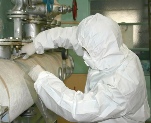










Call us anytime at (888) 317-1447

© 2018 SilverScope,S.E.N.C. All Rights Reserved
| Home | About Asbestos | About Us | Services | Air Quality | Sample COC | Contact Us |


What is Asbestos:
Asbestos is a collective term for naturally occurring minerals that exhibit an extremely fibrous crystal habit. Asbestiform minerals form dense bundles of very fine crystals. Several asbestos varieties have been legally defined as a result of their potential to cause health problems.
Where asbestos can be found:
Many building materials are composed of some percentage of asbestos. Click for a list of common asbestos-containing materials.
About Asbestos in the industrial hygiene and environmental industries
Asbestos Types:
There are currently six (6) regulated asbestos types classified according to both chemical and physical properties. In order of relative abundance within standard building materials the regulated asbestos types include:
- Chrysotile:
- Amosite:
- Crocidilite:
- Tremolite:
- Actinolite:
- Anthophyllite:
In addition to the regulated asbestos types Libby Amphibole, another asbestiform mineral often found within vermiculite attic insulation, is also dangerous.
How asbestos is identified: Physical properties/analytical parameters:
Most any crystalline material can be characterized according to its physical properties through the practice of polarized light microscopy (PLM). As pertains to asbestos analysis, there are a number of analytical parameters used to accurately identify asbestos types and also verify the presence of non-asbestos fibers within a building material. The following parameters are considered in routine sample analysis:
Morphology - this refers to the overall shape of the material (e.g. wavy fibers, or straight needlelike fibers).
Absorbance (color) - simply the color observed in plane polarized light (without use of the upper analyzer of the microscope). Certain materials exhibit pleochroism, or slight changes in color depending upon the orientation of the material in relation to the ocular crosshair.
Refractive index - transparent materials transmit light at a certain speed versus that of the speed of light in air. This value/ratio is referred to as the material’s refractive index and is a highly dependable measurable property usually quite specific to any transparent material. Most materials and all asbestos types have differing refractive indices based on their orientation to a polarized light source. These refractive indices can be measured with accuracy when a sample is prepared within a liquid (typically an oil) of known/calibrated refractive index.
Birefringence/Interference color - birefringence is a calculated value for the difference in two refractive indices of a material. The greater the difference in the speed of light transmitted through a material when the length of the material is oriented either parallel or perpendicular to the polarizer, the higher the birefringence value. Birefringence causes interference colors within the polarized microscope. These colors can be compared to charts to estimate the relative birefringence in terms of low to high.
Extinction angle - during PLM analysis, certain materials will become “extinct”, or turn black when oriented parallel to ocular crosshairs while others will become extinct at a measurable angle from the perpendicular crosshairs.
[ Français ]

Health Risk of Asbestos:
Due to the highly fibrous nature of asbestos, these crystals are easily broken/cleaved into extremely fine dust-like particles, which upon being disturbed become both airborne and inhaleable. Inhalation of asbestos fibers (which persist within the respiratory tract) causes health risks when these fibers become lodged within the lungs and surrounding tissues potentially leading to physical respiratory system damage (asbestosis), lung cancer, or mesothelioma.